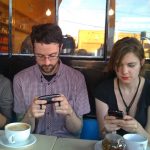
Social media, from blogs and wikis to sites such as Facebook or Twitter, are now common features of everyday life for many people. They provide the opportunity to share experiences of illness and to learn from the shared experiences of others, and previous research has shown this is particularly the case for people managing long-term health conditions.
The authors of this recent study (Fergie et al, 2016) wanted to explore not only how young adults with chronic conditions engage with health information they find online, but also how they contributed as ‘producers’ of that online information.

This qualitative study explored how online engagement with user-generated content can support people with long-term health conditions.
Methods
- Participants were defined as ‘young adults’, aged 18-30, with a diagnosis of diabetes or a ‘common mental health problem’ such as depression or anxiety. They recruited participants both through ‘offline’ and online means
- They completed semi-structured interviews with 40 participants
- During the interviews, the participants were provided with a tablet computer to consider various content examples (from different platforms and also different types of materials, such as text and video), intended to ‘stimulate wider discussion’.
Results
- The authors identified a typology of users, from “non-engagers” who did not access or contribute much online and focused on their offline support, to “tacit consumers” who accessed information online but didn’t create any themselves, to “prosumers” who do both
- These types were linked consistently with the users experience of ‘offline’ support. Non-engagers were more satisfied with support from family or professionals and so less likely to seek additional support. “Prosumers” were more independent and reported that their online experiences provided both technical/factual information and emotional support that they were not getting offline
- The authors also found that the participants’ activities online were guided by clear ideas about how specific online platforms are best used, or conscious decisions about how experiences should be shared based on how the platform is typically used.

A key determinant of participants’ engagement with online resources was their offline experiences of support.
Conclusions
The authors state:
the typology we propose explicitly references how engagement with sources of support offline might impact engagement with user-generated content as a means of accessing accounts of other people’s experiences and peer support. Our research suggests some of the circumstances which might lead to users occupying these types, in particular their offline experiences of support and related factors such as age at diagnosis and current phase of illness. Other characteristics of users, such as gender, did not relate to ‘type’.
I think the key here is that young adults can have different approaches to online production and consumption, entwined in specific ways with the users’ experiences in ‘the real word’. I liked very much how age of user here wasn’t simply to add a novel sampling aspect but was actually considered and integrated into the analysis; specifically, how participants who were older when they received a diagnosis were more likely to adopt an independent approach. I think it’s good to see attention on not just the consumption of online health information, but what is happening for people who create and share information about their health (this paper by Ziebland and Wyke (2012) is a great example of this).
I also really liked how the authors discussed how use varied according to platforms (such as how Facebook was treated differently to Twitter). I think we need to start trying to grasp the nettle of how varied ‘social media’ really is. The authors say:
As health departments and charities attempt to utilise social media platforms to reach specific audiences, it seems important to consider each platform separately. In particular, the genres of content a particular platform hosts, and the established conventions related to the platform’s interactive features, are key concerns of users as they consume and/or produce health-related content.
The authors suggest ‘profiling’ users could be useful, identifying those with less offline support as those who are likely to be ‘prosumers’ and using this to guide what resources are provided (for example, making sure there is an opportunity for the peer to peer sharing that these users valued). Identifying what those users want from a combination of offline and online support, and how to balance recognition of their independence and self-led management with support from services, may be more complex. I think this is another case where Victoria’s call yesterday for more coproduction is spot on; working with those users themselves, to find out what they want, will be vital.

It’s important that different websites are considered separately and not bundled together into a homogenous pool of social media.
Limitations
- I might have expected more discussion comparing the two sample diagnoses and perhaps comparing online experiences regarding physical and mental health. The authors state that there were more similarities than differences, which is just as interesting as a finding, as it perhaps suggests that the commonality of managing a long-term condition is key here rather than the specific illness. I would have liked to see this drawn out or supported more.
- The authors acknowledge their sample is limited in terms of ethnicity and socio-economic status. Research with more diverse samples is essential, for example if we are to address fears about creating “digital divides” that further embed health inequalities (as mentioned by the authors in their introduction).
- Providing materials during the interviews is interesting and I would have liked to see this discussed more. Did these impact the interviews directly (and so would this method be recommended for future studies?), how much were these preselected compared to letting users choose information to focus on, and so on.
- I wonder if the issue of “prosumers” feeling less satisfied with conventional services could have been explored more, including whether the authors think services need to do more to engage with such people. We’ve blogged previously on a study which considered how people who are active online can be both “collaborators” with professionals, or consider them to be entirely separate.

The Internet offers opportunities to access other people’s experiences in a positive way, especially where offline peer-support is lacking or deemed inappropriate.
Links
Primary paper
Fergie G, Hunt K, Hilton S. (2016) Social media as a space for support: Young adults’ perspectives on producing and consuming user-generated content about diabetes and mental health, Social Science & Medicine, Volume 170, December 2016, Pages 46-54, ISSN 0277-9536, http://dx.doi.org/10.1016/j.socscimed.2016.10.006
Other references
Ziebland S, Wyke S. (2012) Health and illness in a connected world: how might sharing experiences on the internet affect people’s health? Milbank Q. 2012 Jun;90(2):219-49. doi: 10.1111/j.1468-0009.2012.00662.x.
How do people with psychosis use online health information, and do they tell their clinicians?
Photo credits
